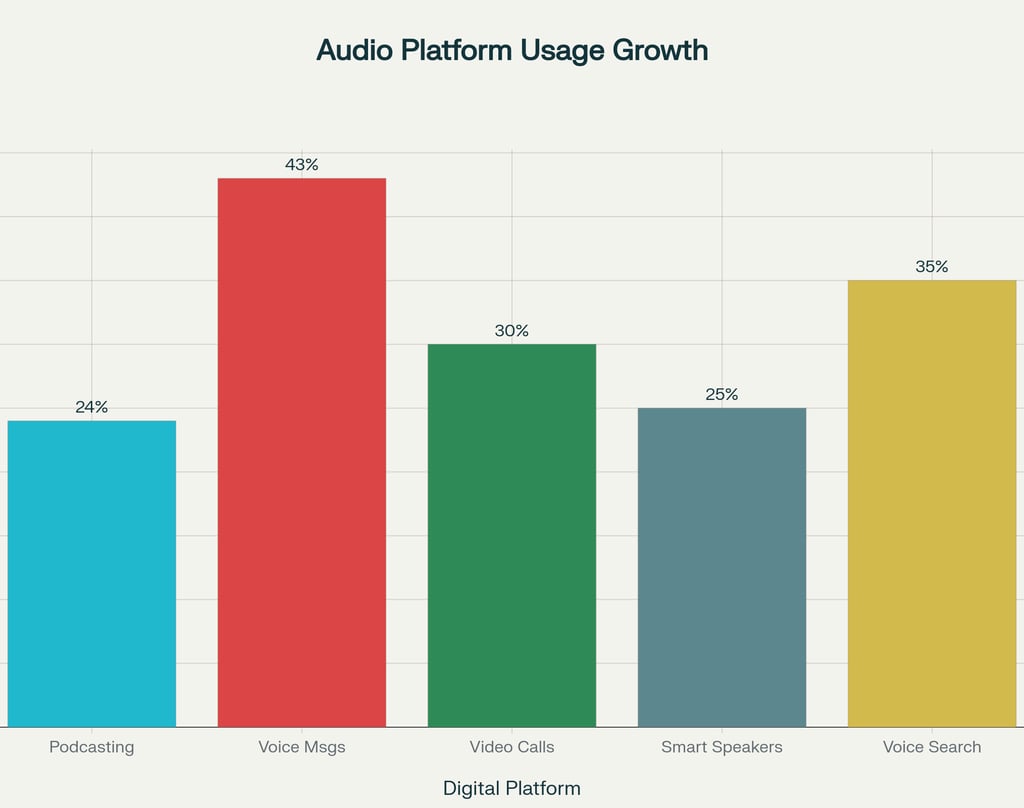The Great Oral Renaissance: How Technology is Reviving the Ancient Art of Spoken Communication in Western Societies
Western societies are rediscovering oral communication after centuries of print dominance. Technology is fueling an unprecedented renaissance of spoken interaction. This shift is transforming how we connect, learn, and share knowledge. Its impact extends deeply into education, business, and cultural expression.
10/20/20256 min read


The Technological Catalysts of Change
The resurgence of orality in Western societies is being powered by several converging technological forces that have made voice communication more accessible, immediate, and natural than ever before.
Voice Assistants and Smart Speakers have emerged as the most visible symbols of this transformation. Research indicates that 25% of US households now own smart speakers, with these devices fundamentally altering how we interact with technology and information. Unlike traditional interfaces that require visual attention and manual input, voice assistants enable us to communicate with machines using our most natural form of expression: speech.
As noted in recent studies, "Voice assistants are software programs that interact with us using automatic speech recognition... Today, with a simple voice command, we can enjoy our favourite song, artist or genre from digital streaming apps". This seamless integration of voice into our daily routines represents a return to the immediacy and naturalness of oral communication that characterized pre-literate societies.
The Podcasting Revolution perhaps best exemplifies this oral renaissance. The percentage of Americans who listen to podcasts has doubled from 12% to 24% in just four years, with the global podcasting market reaching $22.6 billion in 2024 and expected to grow to $167.6 billion by 2033. This explosive growth reflects more than entertainment consumption—it represents a fundamental shift toward valuing authentic, conversational content over formal, written media.
The appeal of podcasting lies in its ability to restore what media theorist Walter Ong identified as the "humanness" of oral communication. Unlike written content, podcasts preserve tone, emotion, and the spontaneous flow of natural conversation. As one industry analysis notes, "The unscripted, long-form nature of most podcasts allows for deep conversations, making them feel personal and relatable".
Digital Orality: Redefining Communication
The concept of "digital orality" helps us understand how modern technology is creating new forms of communication that blend oral and literate traditions. Digital communication platforms have increasingly adopted characteristics that mirror spoken language rather than formal writing.
Social media interactions now feature shorter, fragmented sentences that replicate the spontaneity of spoken language. Emojis and GIFs serve as digital substitutes for body language and facial expressions, while voice messages and audio posts enable users to convey nuance and emotion impossible to capture in text alone.
Video calling platforms have further accelerated this transformation, particularly following the COVID-19 pandemic. Research shows that 30% of people increased their video call usage during the pandemic, with studies revealing that "video calling was superior to face-to-face communication when interacting with a close friend or family member". This finding challenges traditional assumptions about the primacy of in-person interaction and suggests that digital oral communication can, in some contexts, enhance rather than diminish social connection.


The Generational Divide and Convergence
The return to orality reveals fascinating generational patterns that illuminate broader shifts in communication preferences across Western societies.
Generation Z, having grown up as "digital natives," demonstrates a complex relationship with oral communication. While this generation is known for preferring visual and immediate forms of messaging, they simultaneously show strong preferences for authentic, personalized communication. Remarkably, 60% of Gen Z members "claim they dread making phone calls" for tasks like setting appointments, yet 80% will communicate directly with brands through social media voice features.
This apparent contradiction reveals a nuanced shift: younger generations are not rejecting oral communication per se, but rather embracing new forms of it that align with their values of authenticity and personalization. Voice messages, audio posts, and interactive live streams have become preferred alternatives to traditional phone calls, maintaining the benefits of vocal communication while providing greater control and context.
Millennials and older generations are also participating in this oral renaissance, often serving as bridges between traditional and digital forms of spoken communication. Their adoption of podcasting, audiobooks, and voice assistants demonstrates that the appeal of oral communication transcends generational boundaries.
Cognitive and Cultural Implications
The return to orality carries profound implications for how we process information and relate to one another. Research comparing reading and listening reveals distinct cognitive pathways and outcomes that help explain the appeal of audio content.
Studies suggest that "listening to audiobooks elicits a more intense physiological and emotional reaction than watching films or television," while 60% of listeners report that "spoken-word audio allows them to process information more efficiently". This enhanced emotional resonance and processing efficiency may explain why audio content has become increasingly popular for everything from education to entertainment.
The shift also reflects changing attention patterns in Western societies. The convenience of audio content—its ability to be consumed while multitasking—aligns with increasingly busy lifestyles and shorter attention spans. As one analysis notes, "Unlike video content, which requires full visual attention, podcasts allow listeners to multitask... making podcasts an attractive option for individuals who want to consume valuable content without disrupting their day-to-day activities".
The Historical Context: From Literacy Back to Orality
To understand the significance of this transformation, we must consider it within the broader historical context of human communication. Media theorist Walter Ong's foundational work on orality and literacy provides crucial insights into this phenomenon.
Ong distinguished between "primary oral cultures" (which have never known writing), cultures with "craft literacy," and modern societies characterized by "secondary orality"—oral communication that emerges from and coexists with literacy and print culture. Today's digital oral renaissance represents an evolution of this secondary orality, enhanced by technological capabilities that were unimaginable in Ong's time.
Unlike traditional oral cultures that relied on memory and repetition, our contemporary oral renaissance is supported by digital storage and instant access to vast information repositories. We can now combine the immediacy and emotional richness of oral communication with the permanence and searchability traditionally associated with written text.
Challenges and Considerations
The return to orality is not without its challenges and potential drawbacks. Research on voice assistants reveals concerning implications for social behavior, particularly among children. Studies document cases where children's interaction with voice assistants—characterized by commands and demands—begins to influence how they communicate with human beings, potentially undermining courtesy and empathy in interpersonal relationships.
Privacy concerns also loom large as voice-activated devices become ubiquitous in homes and workplaces. The always-listening nature of these technologies raises questions about surveillance and data security that societies are still learning to navigate.
Furthermore, the shift toward audio content may have implications for critical thinking and deep learning. Some research suggests that reading text may engage different cognitive processes than listening, potentially affecting comprehension and retention in ways we are only beginning to understand.
The Future of Oral Communication
As we look ahead, several trends suggest that the oral renaissance in Western societies will continue to accelerate and evolve.
Artificial Intelligence and Natural Language Processing will make voice interactions increasingly sophisticated and natural. AI-powered voice assistants will evolve from reactive command-followers to proactive conversational partners capable of complex reasoning and contextual understanding.
Spatial Audio and Immersive Technologies will enhance the emotional and psychological impact of oral communication, creating more engaging and memorable experiences across educational, entertainment, and professional contexts.
Voice Authentication and Personalization will make oral communication increasingly secure and tailored to individual preferences, potentially replacing traditional text-based interfaces in many applications.
Implications for Organizations and Individuals
The oral renaissance presents both opportunities and challenges for organizations and individuals navigating this transformed communication landscape.
For Businesses, embracing voice-first strategies becomes increasingly critical. Companies must develop audio content strategies, optimize for voice search, and create conversational interfaces that align with changing consumer preferences. The rise of voice commerce and audio advertising represents new revenue streams and customer engagement opportunities.
For Educators, the shift toward oral communication offers new pedagogical possibilities while requiring adaptation of traditional literacy-focused curricula. Audio-based learning, interactive voice technologies, and conversational AI may become central to future educational experiences.
For Individuals, developing "digital oral literacy"—the ability to effectively communicate through voice-enabled technologies—becomes a crucial 21st-century skill. This includes understanding how to optimize voice interactions, leveraging audio content for learning and professional development, and maintaining human connection in an increasingly voice-mediated world.
Conclusion: Embracing the Oral Future
The return of orality to Western societies represents more than a technological shift—it reflects a fundamental human desire for authentic connection and natural communication. As we navigate this transformation, we must thoughtfully consider how to harness the benefits of oral communication while mitigating potential risks.
The challenge ahead lies not in choosing between oral and literate modes of communication, but in creating synergistic relationships between them that enhance human understanding, connection, and expression. As we stand at this inflection point in communication history, the societies that successfully integrate oral and literate technologies will be best positioned to thrive in an increasingly connected and conversational world.
The great oral renaissance is not merely changing how we communicate—it is reshaping who we are as social beings. By understanding and embracing this transformation, we can harness the power of human voice to build more empathetic, engaged, and effective communities in the digital age.
Sources
Alphatec.co.in – "Voice Assistants And Smart Speakers: Changing The Way We Interact With Audio Devices" (2024)
Annual Reviews – Theoretical exploration of audio-based digital narratives (2025)
British Medical Journal (PMC) – COVID-19 related shifts in social interaction and connection through video calls (2022)
Bazaarvoice.com – How to find and use audio trends on social media (2023)
Donald Clark Blog – Ong: Orality, Literacy and New Technologies? (2024)
LinkedIn.com – The Podcast Boom: Why Audio Content Is More Popular Than Ever (2025)
LinkedIn.com – Voice Technology in 2024: Steering the Future of Interaction (2024)
PMC (National Institutes of Health) – Radio, Podcasts, and Music Streaming impact study (2024)
ScienceDirect – Understanding video conferencing social connection and well-being, "Zoom fatigue" (2023)
ScienceDirect.com – Research on teenagers’ interaction with AI-enabled voice assistants during COVID-19 (2023)
VisualCapitalist.com – The Podcasting Boom Explained (2019)
OutspokenVoices.com – Voice Over Trends in the Social Media Landscape (2023)
Eptura.com – Bridging communication gaps across generations (2025)
PerfectlyClearCommunications.com – How COVID-19 is Changing the Way We Communicate (2020)
RelationDif.com – Digital Communication vs. Face-to-Face Communication: Key Differences (2025
